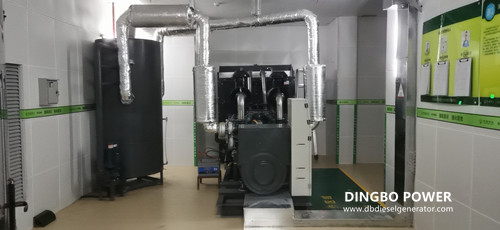dingbo@dieselgeneratortech.com
+86 134 8102 4441

- Home
- Products
- About Us
- Service
- News
- Technical Support
- Contact Us
dingbo@dieselgeneratortech.com
+86 134 8102 4441
Jul. 24, 2021
The basic difference between DC Generator and syncrhonous generator can be understood from their names, DC generator gives Direct Current(DC) and Synchronous Generator gives Alternating Current(AC).
What is a generator?
A generator is a electro-mechanical device that converts Mechanical Energy into Electrical Energy.
What is the principle of generator?
An EMF is induced in a conductor cutting through magnetic flux. Faraday's law of induction.
According to this principle, to generate electricity one needs:
A magnetic field.
A conductor placed inside the field.
A mechanism to create relative velocity between the two.
A mechanism to extract the electricity from the conductor.
A DC generator, as the name suggests generates, DC electricity. In this case the field is stationary. The field winding along with the poles upon which the field winding is wound and the yoke, the outer frame of the machine, with which the poles are joint is called the stator. Inside the stator there is the armature formed of armature core and armature winding, which is called the rotor.

When the rotor is rotated by some external means the armature coil cuts through the magnetic field created by the stator. The electricity produced thus is extracted by dint of slip rings and copper or carbon brush. The electricity produced is not DC initially, it’s single phase AC.
By using commutator this bidirectional AC is converted to unidirectional AC. This is unidirectional but not purely DC.
Depending on the how the field circuit is arranged DC generators are of 2 kinds:
Separately excited:the field is energized by a external DC source.
Self Excited: a portion of the generated EMF is used to energize the field circuit. Here residual magnetism is made use of to generate the initial electricity. There are 3 types of self-excited DC generators:
Shunt Generator- Field is in shunt with the armature.
Series Generator- Field is in series with the armature.
Compound Generator- It's a combination of both series and shunt mechanism.
A synchronous generator- works on the same principle but generates 3-phase AC. There is another important difference, in case of DC generator the field is stationary, but in case of synchronous generator field is rotating and the armature is stationary. The stator is house to 3-phase winding. The voltages generated in these windings are 120 degrees apart from each other in phase. Synchronous generators are high-power robust machines.
The advantage of stationary armature is that, it eliminates slip rings and brushes from the scenario, electricity can be extracted directly from the armature terminals making the process more efficient by reducing contact loss. The field circuit is excited by a brushless exciter circuit mounted on the rotor shaft.
It is a small AC generator the armature of which is mounted on the rotor shaft and the field is stationary. The field of the exciter being stationary is supplied with external dc. With rotation of the rotor, 3-phase ac generated which is converted to dc using 3-phase rectifier also mounted on rotor. This DC is used to energize the main field.
The rotor is rotated using prime mover which can be of many types,for example: steam turbine, water turbine, wind turbine, engine and etc.
For diesel generator set, all most are equipped with AC generator. We hope above information is helpful to you to learn about generators.
Quicklink
Mob.: +86 134 8102 4441
Tel.: +86 771 5805 269
Fax: +86 771 5805 259
E-mail: dingbo@dieselgeneratortech.com
WhatsApp: +86 134 8102 4441
Add.: No. 10 Kechuang Road, High tech Zone, Nanning, Guangxi, China